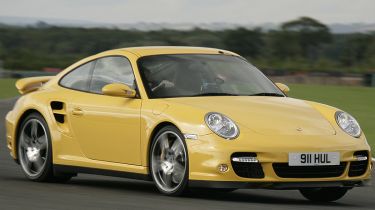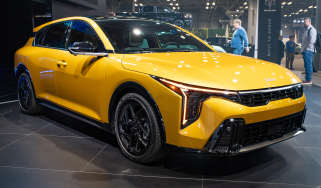Porsche 911 Turbo (2004-2011) review
The 911 Turbo is an incredible piece of technology, yet is as easy to live with as any other Porsche

Driving
On the road, there's no doubting the 911 Turbo's supercar credentials, because the acceleration is simply mind blowing. The Turbo achieved the fastest 0-60mph time we have ever recorded - 3.5 seconds. It's a testament not only to the four-wheel-drive traction, but also the mighty engine, which delivers 680Nm of torque from only 1,950rpm. In fact, it's the powerplant's flexibility which stands out. Even at low revs in sixth gear, there is never any need to change down. The gruff 480bhp 3.6-litre flat-six does wail at higher revs, but it's never as tuneful as vee-engined competitors. However, while it's savagely fast, the Porsche is easy to drive and free from drama, and at sensible road speeds, the huge amounts of grip mean you hardly scratch the surface of its dynamic abilities. But while the steering is very direct, the Turbo lacks the precision and balance of lesser 911s. Driving at the limit on a track requires skill too; understeer can be an issue, and balancing it with the throttle requires quick reactions to catch the resulting oversteer. The optional composite brakes deliver fantastic fade-free stopping power, though, and the Turbo is an awe-inspiring piece of technology that provides phenomenal levels of performance. But is it simply too capable? Only at speeds that are impractical on the public road does the 911 come alive and offer the involvement you expect.
Marketplace
By sports car standards, the 911 is common. But you don't have to be a Porsche anorak to realise the Turbo version stands out - it looks more powerful and aggressive than other models in the range. A widened bodyshell and flared rear wheelarches are the first giveaway; then you'll spot the gaping intakes that feed the rear-mounted turbo intercooler, plus bigger bumpers and extended rear wing (with upper section which raises above 75mph) that shout speed. Fin-like front LED indicators are also specific to the Turbo. In this rarefied world of ultra-fast sports cars, rivals are few: probably the 911 Turbo's most obvious competitor is the even costlier Lamborghini Gallardo, though Mercedes and Aston Martin will also point to their high-powered alternatives.
Owning
The Turbo is the first 911 to have aluminium doors, which help to save weight. This loss of mass is impressive given that the Turbo is packed with more equipment than ever before. The cabin is standard 911 - complete with trademark five-pod dials - and as with all Porsches, offers a colossal variety of options. The standard seats come with electric adjustment and offer exemplary comfort and support, while the driving position is hard to fault and all the controls are beautifully weighted and ideally located. What's more, it's quite practical for a supercar. There's a surprisingly spacious boot in the nose, and the tiny rear chairs can be folded flat to make room for luggage (good job, as they're of no use to passengers). If only it were a little more exciting; it's simply not a very thrilling place in which to spend time. It is one of the most reasonable supercars to run though - we cracked 20mpg, insurance isn't obscene given the massive performance, while even servicing is on a par with more mainstream models. It is expensive though. Add a few all-important options and the price will be quickly into six figures!







